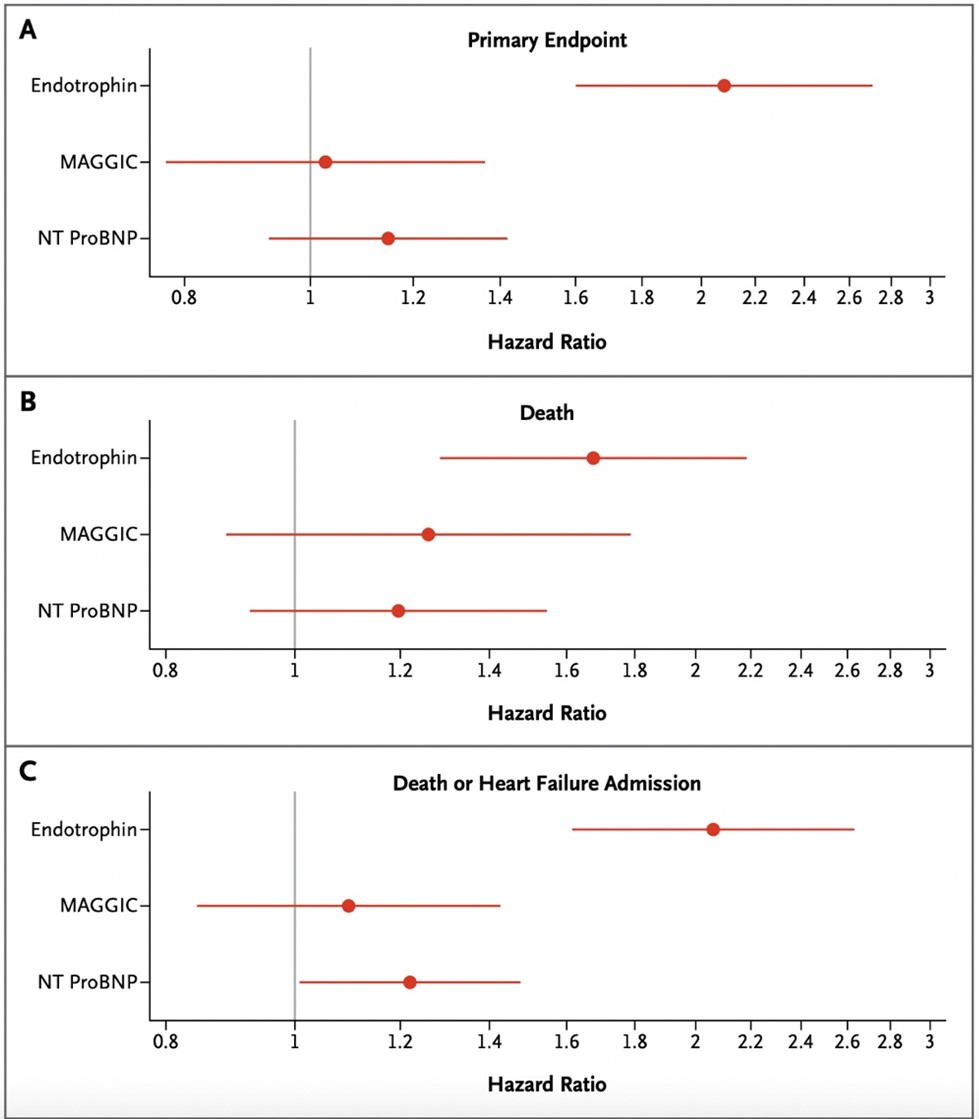Measuring endotrophin (ProC6) in plasma predicts the risk of death, heart failure admission, and composite cardiovascular events in HFpEF patients.
Problem:
HFpEF, which accounts for over half of heart failure (HF) cases, is a condition in which the heart cannot supply enough oxygen and nutrients to the body despite normal ejection fraction levels. Widely used biomarkers, such as MAGGIC risk score and NT-proBNP, failed to predict the risk of the disease. Despite the availability of treatments and disease management approaches (e.g., blood pressure management and lifestyle modification), the 5-year mortality remains high at approximately 76% due to unpredicted cardiovascular events. Thus, there is a need for biomarkers that can effectively predict HFpEF.
Solution:
The inventor identified a blood biomarker, endortrophin (i.e., collagen ProC6 neoepitope or ProC6), which strongly predicts the risk of (1) Death, (2) heart failure admission, and (3) other cardiovascular events (e.g., resuscitated cardiac arrest) in HFpEF patients and greatly outperforms other biomarkers (e.g., MAGGIC risk score and NT-proBNP).
Endotrophin (ProC6) is a collagen type VI–derived peptide that has not been studied in human heart failure (HF). To examine the association between circulating endotrophin and outcomes in HFpEF patients, the inventors measured the endotrophin level in plasma samples of 205 patients enrolled in the Treatment of Preserved Cardiac Function Heart Failure with an Aldosterone Antagonist (TOPCAT) trial. Then, the inventors conducted a participant-level meta-analysis (n=810) comprising six independent studies to further validate the findings. They discovered that high plasma concentrations of endotrophin were strongly associated with death, heart failure admission, and other primary endpoints of the trial (e.g., cardiovascular death or resuscitated cardiac arrest).
Advantages:
- A newly identified prognostic biomarker that can predict and stratify the risk of (1) Death, (2) heart failure admission, and (3) other cardiovascular events (e.g., resuscitated cardiac arrest) in HFpEF patients.
- Superior predictive power of death or HF admission compared with MAGGIC risk score alone or combined with NT-proBNP.
- Provide prognostic information that is largely independent of MAGGIC risk score and NT-proBNP.
- Adding endotrophin to existing models (e.g., MAGGIC risk score and NTproBNP) significantly improved their Harrel’s C index and reclassification.
- Potential application in predicting the risk of HF with reduced ejection fraction (HFrEF).

Multivariable Cox proportional-hazards models that include endotrophin (ProC6), NT-proBNP (N-terminal pro B-type Natriuretic Peptide), and MAGGIC (Meta-Analysis Global Group in Chronic Heart Failure) risk score as predictors of: (A) the primary endpoint (including cardiovascular mortality, aborted cardiac arrest, or hospitalization for the management of HF), (B) all-cause death, and (C) death or heart failure–related hospital admission (DHFA) in TOPCAT trials (n=205). The endotrophin levels in plasma were associated with the TOPCAT primary endpoint (standardized hazard ratio [HR]=2.10; 95% CI=1.62–2.71; P<0.001), all-cause death (standardized HR=1.74; 95% CI=1.36–2.24; P<0.001), and DHFA (standardized HR=2.11; 95% CI=1.67–2.67; P<0.001). In all three cases, endotrophin (ProC6) shows stronger associations than NT-proBNP or MAGGIC risk score.